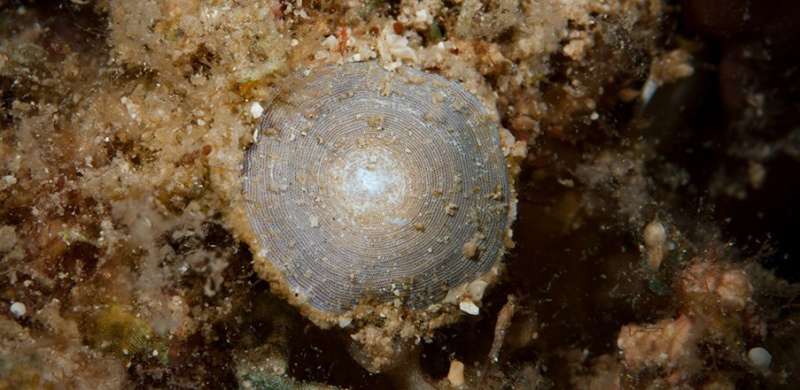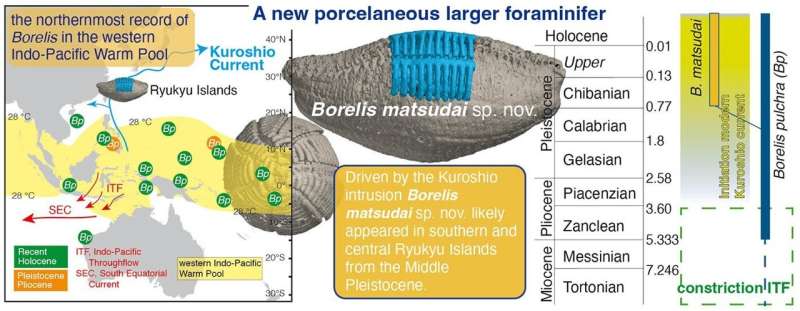This article has been reviewed according to Science X's editorial process and policies. Editors have highlighted the following attributes while ensuring the content's credibility:
fact-checked
peer-reviewed publication
trusted source
proofread
Researchers discover a new species of larger benthic foraminifer from the Ryukyu islands

Foraminifera are tiny, single-celled organisms that live in the oceans. Their hard shells, made of calcium carbonate, can withstand the test of time and their fossils reveal a lot about Earth's history, including past climates and environments.
Now, an international group of researchers have discovered a previously unknown species of large foraminifer, shedding new light on the ecological evolution and biodiversity of coral reefs in the Ryukyu Islands.
Details of their findings were reported in the journal Palaeogeography, Palaeoclimatology, Palaeoecology.
"My colleagues and I have been studying modern and fossil coralline red algae and related carbonate deposits for 15 years," says Yasufumi Iryu, a professor at Tohoku University's Department of Earth Sciences within the Graduate School of Science. "A few years ago, we decided to examine the evolutionary dynamics of the biodiversity of larger foraminifera with porcelain shells from the Oligocene Epoch (about 35 million years ago). At that time, an ocean expanded from the Mediterranean area to the Indo-Pacific."
Large benthic foraminifera form a crucial part of marine communities from warm to tropical waters, especially in coral reefs. Remarkably, only three species of porcelain-shelled large foraminifera are known in today's ecosystems, thriving in the central and eastern Indo-Pacific and the central Atlantic.

Iryu, along with colleagues from Ferrara University, the University of Ryukyus, National Museum of Nature and Science, and University "La Sapienza" of Rome studied numerous paleontological collections deposited in museums and university research institutes. During one analysis, they unearthed specimens of modern large foraminifera from sediment samples of the Sekisei Lagoon, located between Ishigaki Island and Iriomote Island in the southern Ryukyu Islands.
Upon further inspection, the shells had morphological characteristics different to those of the already known species. Studying the architectural features of the cells via computerized micro-tomography, the researchers concluded that it was in fact a new species.
"We named the species Borelis matsudai," explains Iryu. "The later part of the name pays homage to Professor Matsuda Shinya from the University of the Ryukyus, who has spent over a decade researching the Ryukyu Islands' past and present coral reefs." The discovery is the northern most finding of a Borelis species in the western Indo-Pacific, an area marine ecologists dub the Indo-Pacific warm pool.
The dispersal pathway of the Kuroshio Current indicates that Borelis matsudai likely appeared in the southern and central Ryukyu Islands at least since the Middle Pleistocene, around 770,000 years ago. It represents a segment of a population tracing its ancestry back to the widespread Oligocene ancestor, approximately 28 million years ago, in the Philippines.
As global warming continues, the migration of Borelis matsudai to the northern Ryukyu Islands, where it has yet to be found, may be further facilitated. Consequently, the Sekisei Lagoon marks a significant biogeographical milestone in the northward migration of benthic organisms within coral reefs along the Kuroshio Current's dispersal route.
Looking ahead, Iryu plans to explore the relationship between the evolution of large benthic foraminifera (including Borelis) and the marine environment (seawater temperature, partial pressure of carbon dioxide, and pH) over the last 35 million years.
More information: Davide Bassi et al, A new species of the larger porcelaneous foraminifer Borelis provides novel insights into Neogene to Recent western Pacific palaeobiogeographical dispersal patterns, Palaeogeography, Palaeoclimatology, Palaeoecology (2023). DOI: 10.1016/j.palaeo.2023.111764
Journal information: Palaeogeography, Palaeoclimatology, Palaeoecology
Provided by Tohoku University





















